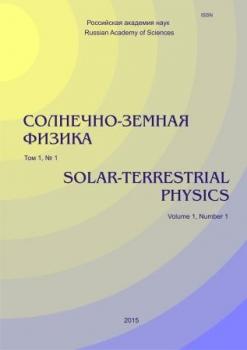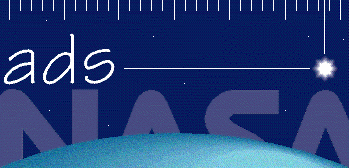Irkutsk, Russian Federation
The paper presents observations of mid-latitude aurora (MA) in the south of Eastern Siberia in solar cycles 23–24. Spectral composition and dominant emissions of MA, daily distribution of MA detection probability, dependence on the level of geomagnetic activity, and classification according to types of aurora are discussed. A close relationship is shown between the intensity of dominant emission at 630.0 nm and the Dst index during magnetic storms (MSs). It is pointed out that the most intense MA are recorded during MS main phases. The MA detected on November 20, 2003 can enlarge the list of great aurora. For the severe MSs (Dstmin< –200 nT) of March 24, 1991, April 6, 2000, October 30 and November 20, 2003, March 17, 2015, the observed dynamics of 557.7 and 630.0 nm auroral emissions is presented. Mechanisms of emission excitation during geomagnetic storms and a possible connection with magnetospheric structures are discussed.
mid-latitude aurora, magnetic storms
1. Afraimovich E.L., Yashkaliev Ya.F., Aushev V.M. Beletsky A.B., Vodyanikov V.V., Leonovich L.A., Lesyuta O.S., Mikhalev A.V., Yakovets A.F. Simultaneous radiophysical and optical measurements of the ionospheric response during a major magnetic storm on April 6, 2000. Geomagnetizm i aeronomiya [Geomagnetism and Aeronomy]. 2002, vol. 42, no. 3, pp. 383-393. (In Russian).
2. Akasofu S. Auroras. Uspehi fizicheskih nauk [Advances in the Physical Sciences]. 1966, vol. 89, no 4, pp. 669-680. (In Russian).
3. Bame S.J., Asbridgie J.R., Felthauseer H.E., Honesa E.W., Strong I.B. Characteristics of the plasma sheet in the Earth’s magnetotail. J. Geophys. Res. 1967, vol. 72, iss. 1, pp. 113-129. DOI:https://doi.org/10.1029/JZ072i001p00113.
4. Barbier D. Recherches sur la raie 630.0 de la luminescence atmospherique nocturne. Ann. Geophys. 1959, vol. 15, no. 2, pp. 179-217.
5. Chamberlan J.W. Physics of the Aurora and Airglow. London, Academic Press, 1961, 722 p. (International Geophysics Series, vol. 2).
6. Cole K.D. Magnetospheric processes leading to mid-latitude aurora. Annales de Géophysique. 1970, vol. 26, no. 1, pp. 187-193.
7. Degtyarev V.I., Mikhalev A.V., Jiyao Xu. Variations of the glow of the night sky in Eastern Siberia in the period of magnetic storm from March 31 to April 4, 2001. Optika atmosfery i okeana [Atmospheric and Oceanic Optics]. 2003, vol. 16, no. 5-6, pp. 552-556. (In Russian).
8. Fairfield D.H., Vinos A.F. The inner edge of the plasma sheet and the diffuse aurora. J. Geophys. Res. 1984, vol. 89, no. A2, pp. 841-854. DOI:https://doi.org/10.1029/JA089iA02p00841.
9. Fishkova L.M., Martsvaladze N.M. On the behavior of HI 656.3 nm and [OI] 630 nm emissions of the upper atmosphere during magnetic storms with a sudden onset. Geomagnetizm i aeronomiya [Geomagnetism and Aeronomy]. 1985, vol. 27, no. 3, pp. 509-511. (In Russian).
10. Galperin Yu.I., Cranier J., Lisakov Yu.V., Nikolaenko L.M., Sinitsyn V.M., Soveaux J.-A., Khalipov V.L. Model of the equatorward boundary of the auroral electron diffusion precipitation zone in the dusk and nearmidnight sectors. Kosmicheskie issledovaniya [Cosmic Res.]. 1977, vol. 15, no. 3, pp. 421-433. (In Russian).
11. Gonzalez W.D., Tsurutani B.T., Clúa de Gonzalez A.L. Interplanetary origin of geomagnetic storms. Space Sci. Rev. 1999, vol. 88, iss. 3-4, pp. 529-562. DOI:https://doi.org/10.1023/A:1005160 129098.
12. Ievenko I.B., Alekseyev V.N. The influence of the substorm and storm on the dynamics of the SAR arc. Statistical analysis. Geomagnetizm i aeronomiya [Geomagnetism and Aeronomy]. 2004, vol. 44, no. 5, pp. 643-654. (In Russian).
13. Khorosheva O.V. Magnetospheric disturbances and the associated dynamics of the ionospheric electrojet, auroras and plasmapause. Geomagnetizm i aeronomiya [Geomagnetism and Aeronomy]. 1987, vol. XXVII, no. 5, pp. 804-811. (In Russian).
14. Kozyra J.U., Nagy A.F., Slater D.W. High-altitude energy source(s) for stable auroral red arcs. Rev. Geophys. 1997, vol. 35, iss. 2, pp. 155-190. DOI:https://doi.org/10.1029/96RG03194.
15. Krakovetsky Yu.K., Loisha V.A., Popov L.N. Chronology the auroras for last millennium. Solnechnye dannye [Solar Data]. 1989, no. 5, pp. 110-115. (In Russian).
16. Lazutin L.L. The auroral oval is a beautiful but outdated paradigm. Solnechno-zemnaya fizika [Solar-Terr. Phys.]. 2015, vol. 1, no. 1, pp. 23-35. (In Russian).
17. Leonovich L.A., Mikhalev A.V., Leonovich V.A. Covariations in atomic oxygen emissions and ionospheric total electron content during geomagnetic storms. J. Atmos. Solar-Terr. Phys. 2012, vol. 80, no. 5, pp. 247-251. DOI:https://doi.org/10.1016/j. jastp.2012.02.003.
18. Lobzin V.V., Pavlov A.V. The relationship of the intensity of the glow of subauroral red arcs with solar and geomagnetic activity. Geomagnetizm i aeronomiya [Geomagnetism and Aeronomy]. 1998, vol. 38, no. 3, pp. 49-61. (In Russian).
19. Mikhalev A.V. Some particulars in observation of mid-latitude airglows and disturbances of the upper atmosphere emissions during magnetic storms in the Eastern Siberia region. Optika atmosfery i okeana [Atmospheric and Oceanic Optics]. 2001, vol. 14, no. 10, pp. 970-973. (In Russian).
20. Mikhalev A.V., Beletsky A.B., Kostyleva N.V., Chernigovskaya M.A. Mid-latitude airglows in the southeast Siberia during strong magnetic storms on October 29-31 and November 20-21, 2003. Kosmicheskie issledovaniya [Cosmic Res.]. 2004, vol. 42, no. 6, pp. 616-621. (In Russian).
21. Mikhalev A.V., Beletsky A.B., Kostyleva N.V., Chernigovskaya M.A. Characteristics of mid-latitude airglows during strong magnetic storms in the current solar cycle. Optika atmosfery i okeana [Atmospheric and Oceanic Optics]. 2005, vol. 18, no. 01-02, pp. 155-159. (In Russian).
22. Mikhalev A.V. Mid-latitude auroras in Eastern Siberia in 1991-2012. Solnechno-zemnaya fizika [Solar-Terr. Phys.]. 2013, vol. 24, pp.78-83. (In Russian).
23. Mikhalev A.V., Beletsky A.B., Vasilyev R.V., Zherebt-sov G.A., Podlesny S.V., Tashchilin M.A., Artamonov M.F. Spectral and photometric characteristics of mid-latitude auroras during the magnetic storm of March 17, 2015. Solar-Terr. Phys. 2018, vol. 4, iss. 4, pp. 42-47. DOI:https://doi.org/10.12737/stp-44201806.
24. Mishin V.V., Lunyushkin S.B., Mikhalev A.V., Kliba-nova Yu.Yu., Tsegmed B., Karavaev Yu.A., Tashchilin A.V., Leonovich L.A., Penskikh Yu.V. Extreme geomagnetic and optical disturbances over Irkutsk during the 2003 November 20 superstorm. J. Atmos. Solar-Terr. Phys. 2018, vol. 181, pt. A, pp. 68-78. DOI:https://doi.org/10.1016/j.jastp.2018.10.013.
25. Nadubovich Yu.A. Morfologicheskie issledovaniya polyarnykh siyaii [Morphological Studies of Auroras]. Novosibirsk, Nauka Publ., 1992, 384 p.
26. Omholt A. Polyarnye siyaniya [Auroras]. Moscow, Mir Publ., 1974, 246 p. (In Russian). (English edition: Omholt A. The Optical Aurora. Springer-Verlag Berlin - Heidelberg, 1971, 200 p. DOI:https://doi.org/10.1007/978-3-642-46269-6.)
27. Rassoul H.K., Rohrbaugh R.P., Tinsley B.A. Low-latitude particle precipitation and associated local magnetic disturbance. J. Geophys. Res. 1992. vol. 97, iss. A4, pp. 4041-4052. DOI:https://doi.org/10.1029/91JA03028.
28. Rassoul H.K., Rohrbaugh R.P., Tinsley B.A., Slater D.W. Spectrometric and photometric observations of low-latitude aurorae. J. Geophys. Res. 1993, vol. 98, iss. A5, pp. 7695-7709. DOI:https://doi.org/10.1029/92JA02269.
29. Rees M.H., Luckey D. Auroral electron energy derived from ratio of spectroscopic emissions. 1. Model computations. J. Geophys. Res. 1974, vol. 79, iss. 34, pp. 5181-5186. DOI:https://doi.org/10.1029/JA079i034p05181.
30. Simmons D.A.R. A classification of auroral type. J. Br. Astron. Assoc. 1998, vol. 108, no. 5, pp. 247-257.
31. Shiokawa K., Ogawa T., Kamide Y. Low-latitude auroras observed in Japan: 1999-2004. J. Geophys. Res. 2005, vol. 110, iss. A5, A05202. DOI:https://doi.org/10.1029/2004JA010706.
32. Shuiskaya F.K. “Red auroras” at mid-latitudes. Polyarnye siyaniya i svecheniya nochnogo neba [Auroras and Night Airglows]. Moscow, Nauka Publ., 1970, no. 18, pp. 97-103. (In Russian).
33. Starkov G.V. Planetarnaya dinamika avroral'nogo svecheniya. Fizika okolozemnogo kosmicheskogo prostranstva [Planetary Dynamics of Auroral Luminescence. Physics of Near-Earth Space], vol. 1. Apatity: Izd-vo Kol’skogo nauchnogo tsentra RAN, 2000, 706 p. (In Russian).
34. Tinsley B.A., Rohrbaugh R.P., Rassoul H., Barker E.S., Cochran A.L., Cochran W.D., Wills B.J., Wills D.W., Slater D. Spectral characteristics of two types of low latitude aurorae. Geophys. Res. Lett. 1984, vol. 11, iss. 6, pp. 572-575. DOI:https://doi.org/10.1029/GL011i006p00572.
35. Tinsley B.A., Rohrbaugh R.P., Rassoul H., Sahai Y., Teixeira N.R., Slater D. Low-latitude aurorae and storm time current systems. J. Geophys. Res. 1986, vol. 91, iss. A10, pp. 11257-11269. DOI:https://doi.org/10.1029/JA091iA10p11257.
36. Truttse Yu.L. Upper atmosphere during geomagnetic disturbances. Polyarnye siyaniya i svecheniya nochnogo neba [Auroras and Night Airglows]. 1973, vol. 20, pp. 5-22. (In Russian).
37. Vallance Jones A. Historical review of great aurora. Can. J. Phys. 1992, vol. 70, iss. 7, pp. 479-487. DOI:https://doi.org/10.1139/p92-083.
38. Zverev V.L., Feldshtein Ya.I., Vorobjev V.G. Auroral glow to the equator from the auroral oval. Geomagnetizm i aeronomiya [Geomagnetism and Aeronomy]. 2012, vol. 52, no. 1, pp. 64-72. (In Russian).
39. URL: http://atmos.iszf.irk.ru/ru/data/spectr (accessed 20 June 2019).
40. URL: http://atmos.iszf.irk.ru/ru/data/color (accessed 20 June 2019).
41. URL: http://atmos.iszf.irk.ru/ru/data/keo (accessed 20 June 2019).
42. URL: http://ckp-rf.ru/ckp/3056 (accessed 20 June 2019).


















